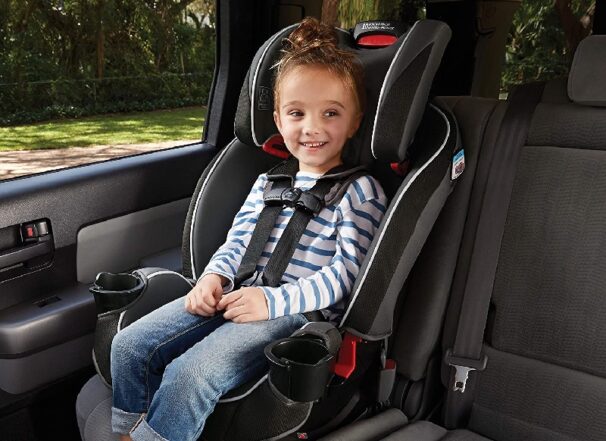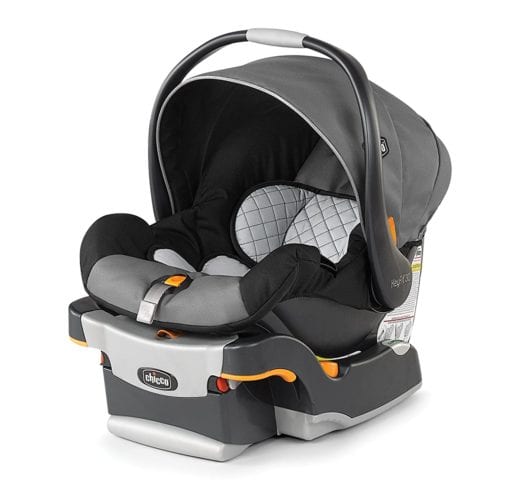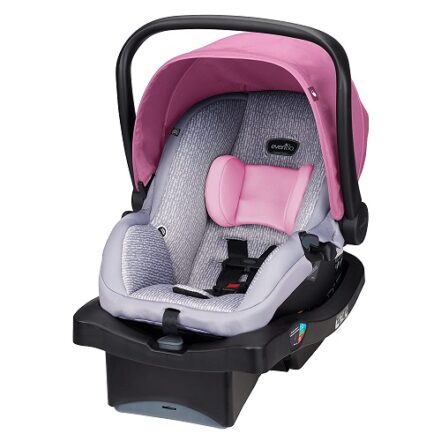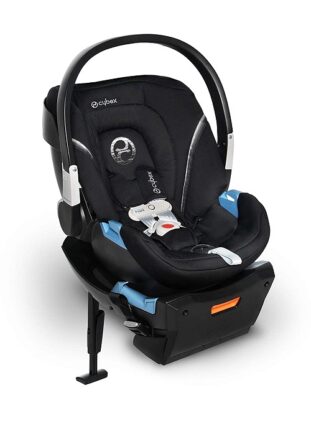A car seat is an essential baby item for all parents with small children – you usually can’t get home from the hospital with your newborn without one! But when you’re deciding what car seat to use for your child, a few questions can crop up. Do you have to buy a new car seat for every child? Is it ok to use a hand-me-down car seat from your family whose kids have outgrown it? Or can you buy one second-hand?
In this article, we take a look at the topic of car seat longevity, to help you make the safest decision for your baby.
Top 4 Best Car Seats – Comparison
What is Car Seat Expiration?
The car seat expiration date is written on the back of the seat, and tells you when the car seat has outlived its useful life. Most car seats are made with an expiration date of six to 10 years, after which you should replace them with a newer model.
Why Do Car Seats Expire?
The expiration date on the seat is a guideline for when to stop using the seat. Although you should never use a car seat after its expiration date, there are some circumstances when a used car seat that is still within its expiration date might not be good for your child.
Wear and tear
A car seat is among the most frequently used baby items. Despite the high-quality petroleum-based plastic materials making up a car seat, it is also subject to normal wear and tear. Environmental factors often bring about wear and tear. For example, changes in temperature from freezing to hot temperatures can gradually degrade and damage the plastic materials on the car seat.
Exposure of the car seat to the sun can damage plastic parts and synthetic fabrics constituting the seat. Exposure to humidity may bring about rust, which destroys the seat’s metal parts. Drinks, food crumbs and other spillages (you know what we mean!) can accumulate dirt in the seat and may stop some mechanics from working properly.
Some cleaning agents, including our best friend the baby wipe, may be harsh on the car seat’s fabrics leading to degradation over time.
Missing parts
A car seat may lose some of its parts during transfer to a stroller and back or when adjusting positions. When that’s the case, avoid using the car seat until you replace the missing parts. Which leads us on to…
Discontinuation of a model
If the manufacturer discontinues the production of a specific car seat model, its replacement parts become impossible to find. This means that if a part of your car seat is broken or missing, you won’t be able to replace it and will need to look for a new car seat.
Recalls by the manufacturer
Manufacturers may recall some of their car seats even when they haven’t expired. This usually happens if there is a malfunction in the design of the seat.
If you need to check whether your seat has been recalled, you can find the company’s customer service number on a sticker located on the side or back of the car seat. You can also check out the NHTSA website for car seat recalls made in the last ten years.
In most cases, manufacturers send replacement parts during recalls, but the manufacturer may advise you to discontinue use and dispose of the seat on rare occasions.
Involvement in a crash
A car seat that has been involved in a crash may have suffered damage that makes it less able to protect your child in the future. Even if you cannot see any external evidence of damage, it’s recommended to replace the car seat after a crash, in the same way you would replace a motorbike helmet after a crash.
Can I Use A Second-Hand Car Seat?
There are several reasons why the authorities recommend not buying used car seats.
It might be expired
There’s no country-wide law prohibiting the use of expired car seats. However, it is illegal to use an expired car seat in some states, such as Virginia, where breaching the law attracts a fine. You can consult your local certified Child Passenger Safety Technician (CPST) to find out the situation in your state. It is unlawful to sell an expired seat, but some parents (knowingly or unknowingly) sell car seats past their expiration date.
It might have been in a crash
While we hope people would be honest about a car seat’s history, not everyone is. Think carefully about the source of the car seat and whether you trust the person to be honest with you when it comes to your child’s safety. This means it might be ok to borrow or buy a second-hand car seat from a friend or family member who you trust, but buying one from an online listing is risky.
Technology and design updates
Manufacturers periodically update their car seat designs to improve performance and keep up with the advancing technology. Thus, a new car seat has more improved functionality and safety features than an old car seat.
Change in safety regulations
Crash tests and safety evaluations are constantly conducted on car seats to ascertain their effectiveness. If regulations change, your car seat may be considered outdated, and you might need to replace it.
How Long Are Car Seats Good For?
Let’s say you have a used car seat – either from your older child, or from a trusted source. How do you know if it’s still good to use?
Most car seats have a lifespan of six to 10 years. However, expiration dates vary with different car seat manufacturers. To avoid using an expired seat, search for a white sticker containing the serial and model number, manufacture date, and car seat expiration date. Other car seat manufacturers imprint the information on a plastic shell.
If you can’t find the information on the seat, search on the manufacturer’s website, read the instruction manual, or call the company’s customer care center. Below is a list of car seat expiration dates for various car seat manufacturers, as well as where to find the expiration date on the seat itself.
Graco
With Graco car seats and boosters, the expiration date is imprinted into the plastic at the seat’s back.
- Infant car seats: seven years
- All-in-one car seats: 10 years
- Convertible car seats: 10 years
- Belt-positioning booster: 10 years
- Harness boosters: 10 years
Chicco
You should find a white label on the underside of the Chicco car seat or the top of the base with the expiration date on.
- Convertible: eight years
- Infant: 6 years
- MyFit Harness + Booster: eight years
- KidFit Belt-Position Booster seat: 10 years
Britax
To find the expiration date on a Britax car seat, check the white sticker located near the seat’s top under the fabric padding.
- Infant: 6 years
- Convertible car seats except (Classic line): seven years
- ClickTight convertible car seats: 10 years
- Harness-2-booster seats: nine years
- One4Life all-in-one seats: 10 years
Evenflo
The expiration date on Evenflo car seats is on the white sticker located at the car seat’s bottom or back and on the user manual.
- Infant: six years
- All-in-one: 10 years
- Booster seat: 6-10 years
- Convertible car seats: 6-10 years according to the model
Uppababy
The expiration date on Uppababy seats is on a label on the seat’s bottom or base.
- Mesa infant seat: seven years
- Knox Convertible: ten years
Baby Trend
With Baby Trend car seats, the expiration date is on the underside of the car seat.
- Infant car seat: six years
- Hybrid stage 1 & 2: six years
- Trooper 3-in-one convertible: seven years
- PROtect convertible: seven years
- Yumi booster & Yumi 2-1: nine years
- Hybrid backless booster: 10 years
Cybex
With Cybex car seats, check under the seat to find the label with the expiration date.
- Infant: six years
- Booster: 10 years
- Convertible Sirona M: eight years
- Convertible Sirona S: ten years
You can also find the expiration date under the seat, under the fabric, or on the seat’s back behind the headrest for brands not mentioned above.
How Can You Discard an Expired Car Seat?
It is best to dispose of your expired car seat appropriately so that no one can reuse it. Start by pulling out the cover and harness straps. Then cut the harness straps into pieces, remove the metal parts, write “DO NOT USE, EXPIRED” on the seat, and put it in a black garbage bag before disposal.
Safety Tips
Know the history
For a new seat, read instructions on the car seat’s label or manual and ensure all the parts are included. For used or old car seats, check the following:
- It has a manufacture date and model number label.
- It hasn’t been recalled.
- It has never been involved in a crash
- It has all the parts and isn’t damaged.
- It is less than 6 years from its date of manufacture and is not expired.
It is best to avoid using a car seat at all if you don’t know its history.
Register
Once you buy a new car seat, register it with the manufacturer to confirm its validity and be contacted if there’s a recall. If you’re unsure or unable to register, a certified Child Passenger Safety Technician from the company can assist you.
Use correctly
- Read the seat’s label and instruction manual to ensure that your child is within the weight, height, and age limits.
- Place your car seat in the back seat, far from the active airbags. For safety, place your baby in a rear-facing position and properly buckle them. Read the instruction manual for correct buckling and recline angles.
- Let your baby remain in a rear-facing car seat until they’ve outgrown it.
- Never leave your baby alone in the car seat or add any accessories unapproved by the manufacturer.
- Heavy outerwear can prevent harness straps from tightening your child properly. Buckle the harness first, then place the blanket to keep your baby warm.
- Avoid transferring your child into a booster seat too soon.
- Note that a car seat isn’t a safe place for your child to sleep.
Installation
Read the company’s instructions as well as your vehicle’s manual for correct installation. Ensure the seat is tightly secured. It shouldn’t allow any movement from front to back or side to side.
Final Thoughts
New car seats are the best option for all parents. Old car seats can have unpleasant histories. They could be faulty or expired, risking your child’s safety. However, you can use an old seat if it’s passed down from your slightly older child or a trusted source. For your baby’s safety purposes, avoid using an expired car seat at all.
A recently manufactured car seat model has more improved features and is safer than previous models. You can check on various companies’ websites and find a car seat suitable for your budget and lifestyle. It is worth noting that both expensive and low-cost car seats have similar safety regulations.
At the end of the day, put safety first and make sure your child’s car seat is up to the job.









